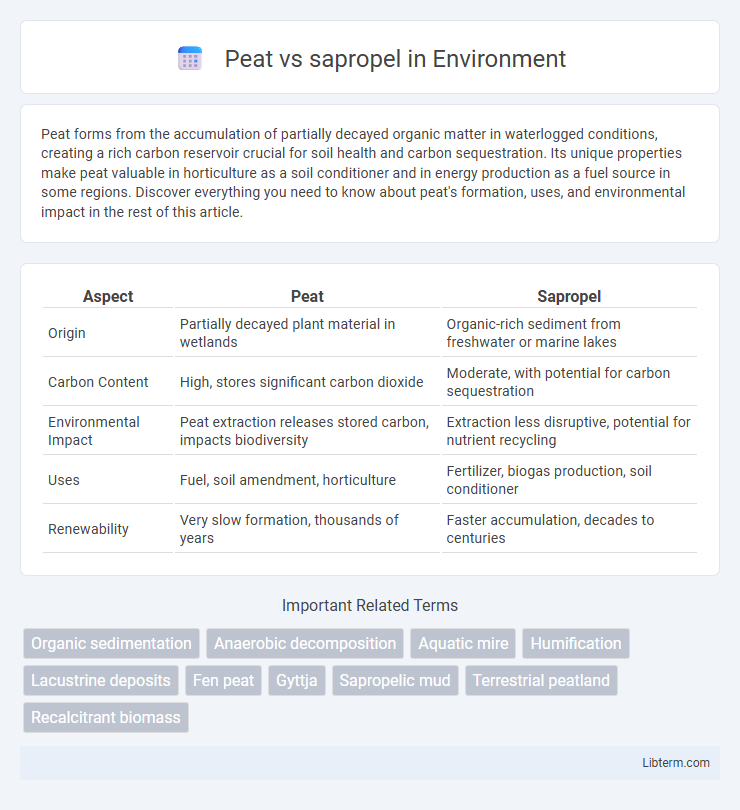Peat forms from the accumulation of partially decayed organic matter in waterlogged conditions, creating a rich carbon reservoir crucial for soil health and carbon sequestration. Its unique properties make peat valuable in horticulture as a soil conditioner and in energy production as a fuel source in some regions. Discover everything you need to know about peat's formation, uses, and environmental impact in the rest of this article.
Table of Comparison
| Aspect | Peat | Sapropel |
|---|---|---|
| Origin | Partially decayed plant material in wetlands | Organic-rich sediment from freshwater or marine lakes |
| Carbon Content | High, stores significant carbon dioxide | Moderate, with potential for carbon sequestration |
| Environmental Impact | Peat extraction releases stored carbon, impacts biodiversity | Extraction less disruptive, potential for nutrient recycling |
| Uses | Fuel, soil amendment, horticulture | Fertilizer, biogas production, soil conditioner |
| Renewability | Very slow formation, thousands of years | Faster accumulation, decades to centuries |
Introduction to Peat and Sapropel
Peat is an organic material formed from partially decomposed plant matter accumulated in waterlogged, anaerobic conditions, primarily found in bogs and wetlands. Sapropel consists of nutrient-rich, fine-grained sediments derived from the anaerobic decomposition of algae and zooplankton in aquatic environments like lakes and marine basins. Both peat and sapropel serve as natural reservoirs of organic carbon and have applications in agriculture, horticulture, and environmental management.
Formation Processes of Peat and Sapropel
Peat forms through the accumulation and partial decomposition of plant material in waterlogged, anaerobic conditions typically found in bogs and mires, where low oxygen levels slow microbial activity. Sapropel develops from the buildup of organic-rich sediment under anoxic conditions in aquatic environments like lakes and marine basins, where fine organic particles and algae settle and are preserved. Both involve organic matter preservation but differ in their depositional environments and dominant biological sources.
Chemical Composition Differences
Peat primarily consists of partially decomposed organic plant material rich in lignin and cellulose, resulting in a high carbon content and acidic pH. Sapropel, formed from the sediment of aquatic environments, contains higher concentrations of humic substances, proteins, and minerals such as nitrogen, phosphorus, and calcium. The key chemical difference lies in peat's lower nutrient content and higher acidity compared to sapropel's richer nutrient profile and neutral to alkaline pH.
Physical Properties and Texture
Peat typically exhibits a fibrous, coarse texture due to partially decomposed plant material, resulting in low bulk density and high porosity. Sapropel has a finer, amorphous texture composed of organic-rich, fine sediment with higher moisture content and greater density compared to peat. Both materials differ significantly in water retention and compressibility, influencing their suitability for agricultural and environmental applications.
Environmental Impact and Sustainability
Peat extraction releases significant amounts of stored carbon dioxide, contributing to greenhouse gas emissions and ecosystem degradation, while sapropel, a nutrient-rich sediment from freshwater bodies, offers a renewable alternative with lower environmental impact. Peatlands take thousands of years to form and their disturbance disrupts biodiversity, whereas sapropel can be harvested more sustainably with minimal habitat loss. Utilizing sapropel supports climate change mitigation goals and promotes sustainable soil amendment practices in agriculture.
Agricultural and Horticultural Applications
Peat and sapropel serve as valuable soil amendments in agriculture and horticulture by improving soil structure, water retention, and nutrient availability. Peat, composed of partially decomposed plant material, is widely used for its acidic pH and organic matter content, making it ideal for acid-loving plants and soil conditioning. Sapropel, rich in organic matter and minerals from freshwater sediments, enhances soil fertility and microbial activity, offering a sustainable alternative to traditional peat with benefits in crop yield and soil health.
Benefits and Drawbacks of Peat
Peat is an organic material composed of partially decomposed plant matter, offering high water retention and nutrient content beneficial for soil conditioning and agriculture. However, the extraction of peat contributes to carbon emissions and habitat disruption, raising environmental concerns compared to sapropel, a mineral-rich sediment with lower ecological impact. While peat improves soil structure and fertility, its use is limited by sustainability issues and the long regeneration times required for peatlands to recover.
Advantages and Limitations of Sapropel
Sapropel offers high nutrient content, rich in organic matter and trace minerals, making it excellent for soil conditioning and improving crop yields compared to peat. It decomposes faster and releases nutrients more efficiently, yet its moisture retention is lower than peat, which may require supplemental irrigation. Limitations include potential contamination from heavy metals and the need for proper processing to eliminate pathogens, restricting its direct use in agriculture without treatment.
Economic Considerations and Availability
Peat is widely available in regions like Canada, Russia, and Finland, making it a cost-effective fuel source for energy production and horticulture, while sapropel, derived from organic-rich lake sediments, has limited accessibility and higher extraction costs. The extraction and processing of peat are more industrially developed, contributing to lower market prices compared to sapropel, which remains niche due to its specialized use in agriculture and environmental remediation. Economic considerations favor peat for large-scale applications, whereas sapropel's value lies in its superior nutrient content and potential as a sustainable soil amendment despite higher initial costs.
Future Trends and Alternatives
Peat extraction faces increasing environmental restrictions due to carbon emissions and habitat destruction, prompting a rise in sapropel utilization as a sustainable alternative for soil conditioning and bioenergy. Advances in sapropel processing technology are enhancing its nutrient retention and reducing contaminants, positioning it as a viable replacement in agriculture and horticulture industries. Future trends emphasize eco-friendly peat alternatives like sapropel, supported by governmental policies promoting carbon neutrality and wetland conservation.
Peat Infographic

 libterm.com
libterm.com